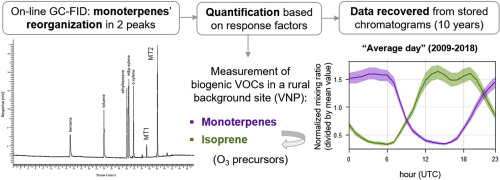当前位置:
X-MOL 学术
›
Atmos. Environ.
›
论文详情
Our official English website, www.x-mol.net, welcomes your feedback! (Note: you will need to create a separate account there.)
Long-term measurement of biogenic volatile organic compounds in a rural background area: Contribution to ozone formation
Atmospheric Environment ( IF 5 ) Pub Date : 2020-03-01 , DOI: 10.1016/j.atmosenv.2020.117315 María Carmen Gómez , Nieves Durana , José Antonio García , Maite de Blas , Estibaliz Sáez de Cámara , Estíbaliz García-Ruiz , Gotzon Gangoiti , Eduardo Torre-Pascual , Jon Iza
Atmospheric Environment ( IF 5 ) Pub Date : 2020-03-01 , DOI: 10.1016/j.atmosenv.2020.117315 María Carmen Gómez , Nieves Durana , José Antonio García , Maite de Blas , Estibaliz Sáez de Cámara , Estíbaliz García-Ruiz , Gotzon Gangoiti , Eduardo Torre-Pascual , Jon Iza

|
Abstract The measurement of biogenic volatile organic compounds (BVOCs) in ambient air is of special interest in rural background areas such as the Valderejo Natural Park (VNP). VNP is a mixed forest area away from important urban centers and where ozone episodes often occur. The main BVOCs at VNP are monoterpenes and isoprene emitted by conifers and deciduous trees, respectively. Volatile organic compounds (VOCs) are routinely measured in ambient air by using a gas chromatography system fitted with flame ionization detection (GC-FID). In order to obtain comparable results with other sites around the world our system was configured following closely the US EPA guidelines for C2–C11 ozone precursors’ measurement in Photochemical Assessment Monitoring Stations (PAMS). On this system isoprene is correctly quantified but monoterpenes suffer some losses and degradation during sampling and analysis, producing two significant chromatographic peaks. In this work, we propose a method to quantify the monoterpenes from response factors, in order to recover their mixing ratios from historical chromatographic databases. Monoterpenes’ mixing ratios have been recovered to create a 10-year database (2009–2018) containing the results of average hourly mixing ratios of more than 60 VOCs, including isoprene and monoterpenes. The highest BVOC mixing ratios are recorded in the summer, both the average seasonal mixing ratio (monoterpenes: 0.32 ppbv, isoprene: 0.06 ppbv) and the maximum average hourly values (monoterpenes: 8.07 ppbv, isoprene: 1.78 ppbv). These biogenic compounds have a distinct daily cycle. Isoprene shows its highest mixing ratios in the middle of the day. The mixing ratio of monoterpenes remains at low values during the day, because of their high photochemical activity, and higher values are observed during the night. Regarding the Ozone Formation Potential of non-oxygenated VOCs at VNP, the greatest contribution corresponds to BVOCs (an average of 51% obtained from 10 years of measurements).
中文翻译:

农村背景地区生物挥发性有机化合物的长期测量:对臭氧形成的贡献
摘要 环境空气中的生物挥发性有机化合物 (BVOC) 的测量在农村背景地区特别受到关注,例如 Valderejo 自然公园 (VNP)。VNP 是一个远离重要城市中心的混交林区,经常发生臭氧事件。VNP 的主要 BVOC 分别是针叶树和落叶树排放的单萜和异戊二烯。通常使用配备火焰离子化检测器 (GC-FID) 的气相色谱系统测量环境空气中的挥发性有机化合物 (VOC)。为了获得与世界其他地点的可比结果,我们的系统严格按照美国环保署关于在光化学评估监测站 (PAMS) 中测量 C2–C11 臭氧前体的指南进行配置。在该系统上,异戊二烯被正确定量,但单萜在采样和分析过程中会遭受一些损失和降解,从而产生两个显着的色谱峰。在这项工作中,我们提出了一种从响应因子量化单萜的方法,以便从历史色谱数据库中恢复它们的混合比。已恢复单萜的混合比率以创建一个 10 年数据库(2009-2018),其中包含 60 多种 VOC(包括异戊二烯和单萜)的平均每小时混合比率的结果。最高的 BVOC 混合比率记录在夏季,包括平均季节性混合比率(单萜:0.32 ppbv,异戊二烯:0.06 ppbv)和最大平均小时值(单萜:8.07 ppbv,异戊二烯:1.78 ppbv)。这些生物化合物具有明显的每日循环。异戊二烯在一天中间显示出最高的混合比例。单萜的混合比在白天保持在低值,因为它们的光化学活性高,而在夜间观察到更高的值。关于 VNP 处非氧化 VOC 的臭氧形成潜力,最大的贡献对应于 BVOC(从 10 年的测量中获得的平均值为 51%)。
更新日期:2020-03-01
中文翻译:

农村背景地区生物挥发性有机化合物的长期测量:对臭氧形成的贡献
摘要 环境空气中的生物挥发性有机化合物 (BVOC) 的测量在农村背景地区特别受到关注,例如 Valderejo 自然公园 (VNP)。VNP 是一个远离重要城市中心的混交林区,经常发生臭氧事件。VNP 的主要 BVOC 分别是针叶树和落叶树排放的单萜和异戊二烯。通常使用配备火焰离子化检测器 (GC-FID) 的气相色谱系统测量环境空气中的挥发性有机化合物 (VOC)。为了获得与世界其他地点的可比结果,我们的系统严格按照美国环保署关于在光化学评估监测站 (PAMS) 中测量 C2–C11 臭氧前体的指南进行配置。在该系统上,异戊二烯被正确定量,但单萜在采样和分析过程中会遭受一些损失和降解,从而产生两个显着的色谱峰。在这项工作中,我们提出了一种从响应因子量化单萜的方法,以便从历史色谱数据库中恢复它们的混合比。已恢复单萜的混合比率以创建一个 10 年数据库(2009-2018),其中包含 60 多种 VOC(包括异戊二烯和单萜)的平均每小时混合比率的结果。最高的 BVOC 混合比率记录在夏季,包括平均季节性混合比率(单萜:0.32 ppbv,异戊二烯:0.06 ppbv)和最大平均小时值(单萜:8.07 ppbv,异戊二烯:1.78 ppbv)。这些生物化合物具有明显的每日循环。异戊二烯在一天中间显示出最高的混合比例。单萜的混合比在白天保持在低值,因为它们的光化学活性高,而在夜间观察到更高的值。关于 VNP 处非氧化 VOC 的臭氧形成潜力,最大的贡献对应于 BVOC(从 10 年的测量中获得的平均值为 51%)。


























 京公网安备 11010802027423号
京公网安备 11010802027423号